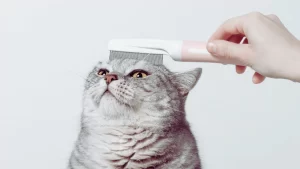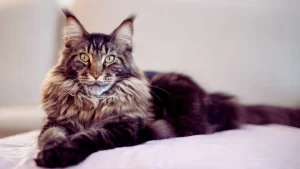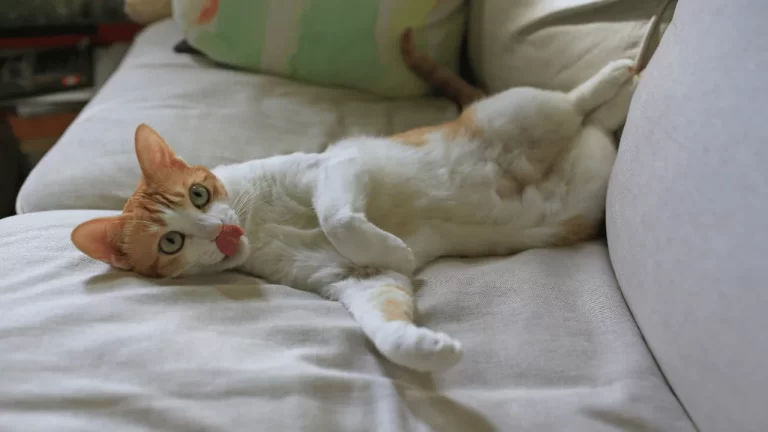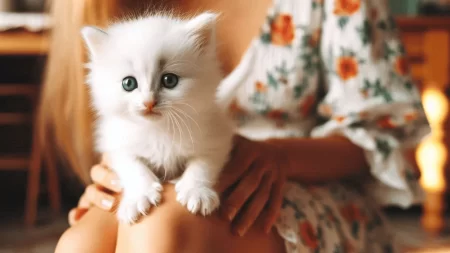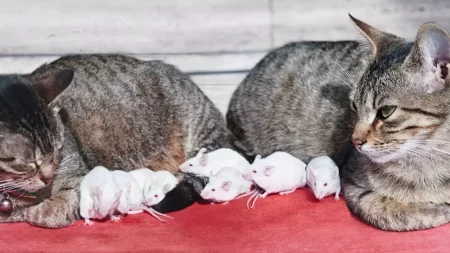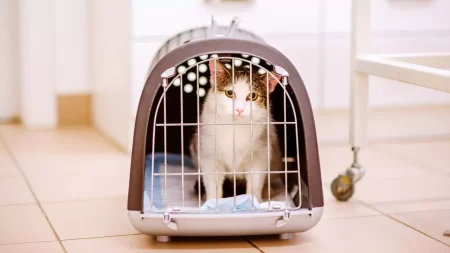If you are a cat lover, you may have experienced this scenario: your cat rolls over on his back, showing you his fluffy belly, and you think he wants a belly rub. But as soon as you touch his tummy, he bites or scratches your hand.
Why do cats do this? Is it a trap or a sign of trust?
The answer is not so simple, as cats have different reasons for exposing their belly and reacting to belly rubs.
In this article, we will explore the behavior of cats, the “cat belly trap” phenomenon, and some tips for interacting with cats.
The Behavior of Cats: Understanding Their Natural Instincts
Cats are complex and fascinating creatures, with a rich history of domestication and adaptation. They have evolved from wild predators to beloved companions, but they still retain some of their natural instincts. Two of these instincts are relevant to the topic of cat belly rubs: instinctual prey defense and trust and vulnerability.
Instinctual Prey Defense
As predators, cats have a strong instinct to protect themselves from potential threats. One of the most vulnerable parts of their body is their belly, where many vital organs are located. If a cat is attacked by another animal, exposing the belly could be fatal. Therefore, cats instinctively guard their belly from any touch, even if it comes from a friendly human. This is why some cats may react aggressively when you try to pet their belly, as they perceive it as a threat or an invasion of privacy.
Trust and Vulnerability
On the other hand, as social animals, cats also have a need for affection and bonding. They communicate with other cats and humans through various signals, such as vocalizations, body postures, facial expressions, and scent markings. One of these signals is exposing the belly, which indicates trust and vulnerability. When a cat shows you his belly, he is telling you that he feels safe and comfortable with you and that he is not afraid of being attacked. This is a sign of respect and affection, and should not be taken lightly.
The “Cat Belly Trap” Explained
So, why do some cats expose their belly and then attack you for petting them? This phenomenon is sometimes called the “cat belly trap”, and it can be confusing and frustrating for cat owners. The reason behind this behavior is that cats have different preferences and tolerances for being touched on their belly. Some cats may enjoy belly rubs, some may tolerate them for a short time, and some may hate them altogether. There are several factors that influence how a cat reacts to belly rubs, such as:
Exposing the Belly as a Sign of Safety
As we mentioned before, exposing the belly is a sign of trust and vulnerability for cats. However, this does not necessarily mean that they want you to touch their belly. In fact, some cats may expose their belly as a way to show you that they feel safe enough to not guard their belly from you. This means that they trust you not to hurt them or invade their personal space. If you try to pet their belly in this situation, you may be violating their trust and making them feel uncomfortable or threatened.
Sensitivity to Touch
Cats are more sensitive to touch on their bellies than on other parts of their body. This is because they have more nerve endings and less hair on their stomachs than on their backs or sides. Therefore, touching their belly may feel ticklish or unpleasant for some cats, especially if you use too much pressure or move your hand too fast. Some cats may also have negative associations with being touched on their belly due to past experiences of pain or trauma.
The Reasons Behind Cats’ Reactions to Belly Rubs
Another factor that influences how a cat reacts to belly rubs is his mood and personality. Cats have different temperaments and preferences for physical contact, just like humans. Some cats may be more playful or affectionate than others, and some may be more shy or independent. Depending on how a cat feels at the moment, he may react differently to your attempt to pet his belly. Some of the possible reasons behind cats’ reactions are:
Play Behavior
Some cats may expose their belly and then attack your hand as a way to initiate play. Cats are natural hunters, and they like to practice their hunting skills by playing with toys or other animals. Sometimes, they may mistake your hand for a toy or prey, and try to catch it with their teeth and claws. This is not a sign of aggression or malice, but rather a sign of excitement and fun. However, this behavior can be painful and dangerous for humans, so it should be discouraged.
Overstimulation or Aggression
Some cats may enjoy belly rubs for a while, but then suddenly bite or scratch your hand without warning. This may happen because they become overstimulated or irritated by the touch, and want you to stop. Cats have a limit to how much physical contact they can tolerate, and they may lash out if they feel overwhelmed or annoyed. This is a sign of frustration or anger, and it should be respected.
Tips for Interacting with Cats
So, how can you interact with cats without falling into the “cat belly trap”? Here are some tips to help you understand and communicate with your feline friend:
Reading the Cat’s Body Language
The most important thing to do is to pay attention to the cat’s body language. Cats are very expressive, and they use various cues to tell you how they feel and what they want. Some of the signs that indicate a cat’s mood and preference for belly rubs are:
- Ears: If a cat’s ears are in a relaxed or forward position, he may be open to belly rubs. If his ears are flattened or turned sideways or back, he may be scared or angry and want you to back off.
- Eyes: If a cat’s eyes are half-closed or blinking slowly, he may be happy and content. If his eyes are wide open or dilated, he may be alert or excited.
- Tail: If a cat’s tail is still or gently waving, he may be calm or playful. If his tail is twitching or lashing, he may be annoyed or agitated.
- Body: If a cat’s body is relaxed or stretched out, he may be comfortable or inviting. If his body is tense or curled up, he may be nervous or defensive.
Approaching Slowly and Gently
If you want to pet a cat’s belly, you should always approach him slowly and gently. You should never force or surprise a cat by touching his belly without his consent. You should also avoid using too much pressure or speed when petting his belly, as this may cause discomfort or pain. Instead, you should use light and gentle strokes, and follow the direction of his fur.
Knowing When a Cat is Receptive to Belly Rubs
Even if a cat shows you his belly, it does not mean that he wants a belly rub. You should always ask for his permission before touching his belly, by extending your hand towards him and letting him sniff it. If he rubs his head or body against your hand, he may be inviting you to pet him. If he moves away or ignores your hand, he may not want to be touched. You should also watch for signs of enjoyment or discomfort while petting his belly, such as purring, kneading, licking, biting, scratching, growling, or hissing. If he shows positive signs, you can continue petting him. If he shows negative signs, you should stop immediately.
Respecting Boundaries and Personal Space
Finally, you should always respect a cat’s boundaries and personal space. You should never force a cat to expose his belly or accept belly rubs if he does not want to. You should also give him enough space and time to relax and feel comfortable with you. Remember that every cat is different, and some cats may never like belly rubs at all. The best way to bond with your cat is to respect his preferences and personality and find other ways to show him your love and affection.
